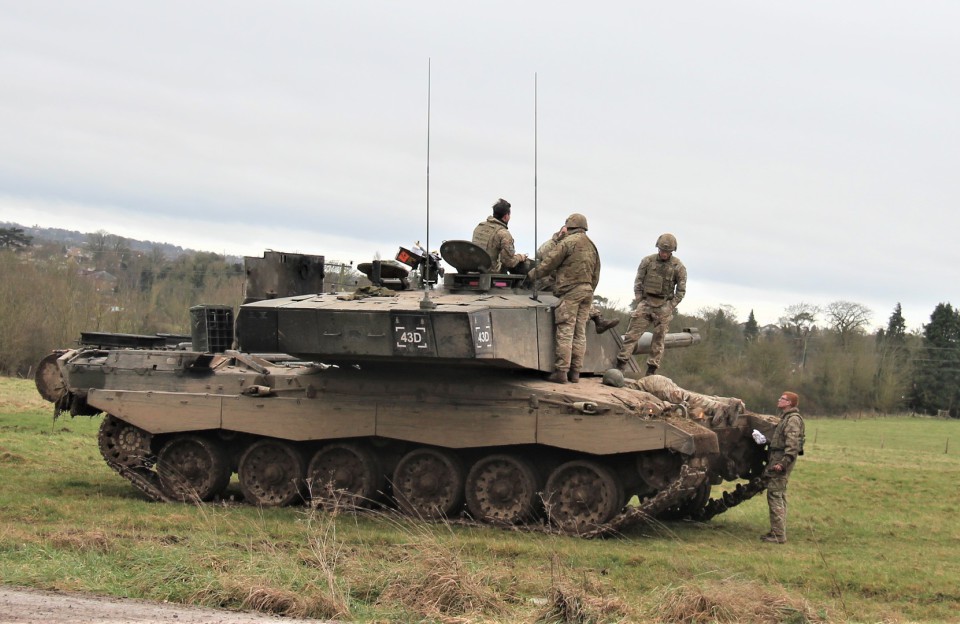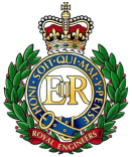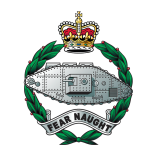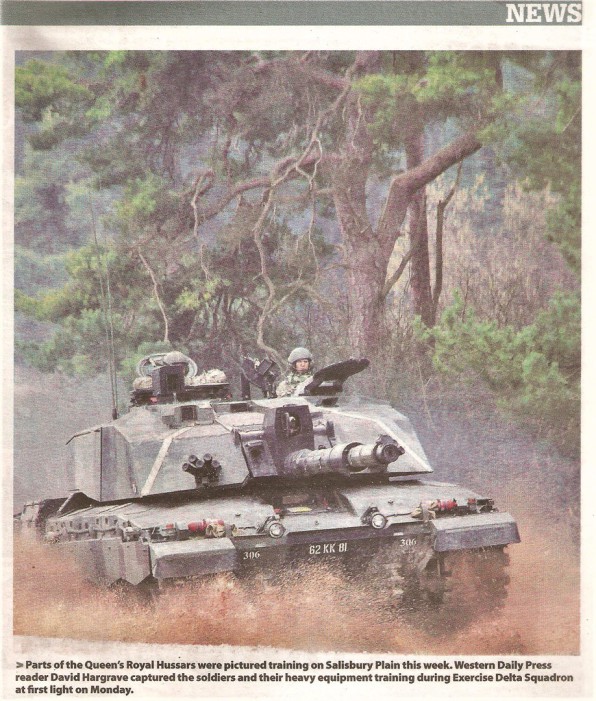
2022 Military on Salisbury Plain
The SPTA Newsletter is now available on line. I hope you find it useful.
www.gov.uk/government/publications/salisbury-plain-training-area-spta-newsletter
26 Engineer Regiment RE - 11.09.22
This is a regiment of the British Army's Royal Engineers.
Each Engineer Squadron provides close support to the units within the Adaptive Force, allowing them to live, move and fight within their area of operations. More
specialised capabilities are also held in the Headquarters and Support Squadron, such as a Reconnaissance Troop, Construction Design Cell, Divers, plant vehicles, and Automotive Bridge Launching
Equipment (ABLE) for General Support Bridging (GSB).
As a unit at high readiness, The Engineer Regiment are ready to fight at short notice anywhere across the world, usually in support of 1 Armoured Infantry Brigade. As a
unit within 8 Engineer Brigade the Regiment is also called upon to deploy more broadly as engineer subject matter experts across the world to advise the UN, NATO or allied armies.2
Bridge Laying using the Unipower M-series -
Extract from military-com
The Unipower M-series range of military trucks was developed by Universal Power Drives in the late 1980s. These high mobility trucks were designed for demanding military
applications. Trucks were intended to carry specialized equipment and used as heavy equipment transporters. First production vehicles were completed in 1992. Alvis Plc acquired the company in 1994
and the trucks began to be branded as Alvis Unipower.
The Unipower M-series chassis has a payload capacity of 24 000 kg. It was proposed for the British Army as a Palletized Loading Systems (PLS), BR90 bridgelayer, heavy
recovery vehicle and fuel tanker.
About 190 BR90 bridgelayers and associated bridge section carriers, based on the Unipower M-series trucks were produced. Deliveries of the BR90 commenced in 1997, however
other versions received no production orders.
An all-metal cab accommodates driver, plus 4 passengers. Cab is equipped with independent heater and air conditioning system. Some vehicles have a roof hatch. A
roof-mounted machine gun mount can be fitted if required.
The Unipower M-series trucks are powered either by Cummins M380E 11-liter turbocharged diesel engine, developing 375 hp, or Perkins 410Tx 12.2-liter turbocharged diesel
engine, 403 hp. Both engines are coupled with automatic gearboxes. In 1997 a new variant of the M-series was introduced, powered by a more powerful Cummins diesel engine, developing 405 hp. The
engine is located behind the cab. On the Unipower M-series trucks the first two pairs of wheels are steered. Vehicles are fitted with a central tyre pressure system. The Unipower M-series have a good
cross-country mobility. They can follow tracked vehicles in the most difficult terrain.
Further development of the M-series was a range of MH-series prime movers. These were heavy duty tank transporters, designed to operate in off-road conditions. These
could transport main battle tanks with a maximum weight of 70 t.
The MH-6600 (6x6) tractor truck was powered by a Cummins KTA-19 19-liter turbocharged diesel engine, developing 600 hp. The MH-8875 (8x8) was powered by a Cummins QSK-19
turbocharged diesel, developing 750 hp. Both vehicles were fitted with a 5-speed automatic transmissions. A fully loaded tank transporter has a maximum road speed of 85 km/h.
These prime movers were equipped with two loading winches. They were used in conjunction with semi-trailers, specially developed by a French Nicolas company. Cabs of
these trucks provide seating for driver, plus 5 passengers.
A number of MH-6600 6x6 tank transporters with associated semi-trailers have been sold to Oman. The MH-8875 8x8 tank transporter was proposed to the British Army, however
the Alvis was eliminated from the bidding process and American Oshkosh M1070 heavy equipment transporter was selected instead.
A number of other proposed M-series variants received no production orders. In the late 1990s production of Alvis Unipower military trucks stopped due to the lack of
orders. By 2000 the M-series was no longer marketed. In 2004 Alvis company was taken over by BAE Systems.
Exercise Iron Storm - 26 Engineers - 07.07.22
This was an armoured exercise and was a free flow exercise. It saw lots of wheeled and armoured vehicles moving both day and night about the area.
The exercise involved mine clearance with a Trojan armoured vehicle and bridge laying, using a Titan armoured vehicle.
Titan is an armoured engineer vehicle designed to enable troops and vehicles to cross gaps of up to 60 metres by laying a selection of close support bridges.
Along with Trojan, it gives a common heavy armour fleet, based on the Challenger 2 Main Battle Tank chassis.
Titan can carry and lay the current range of in-service close support bridges, providing ground manoeuvre formations with improved capability, giving them greater
flexibility. Improved visibility is achieved by incorporating direct and indirect vision systems including low light, image intensifying and thermal imaging capabilities. The interior, and to
some extent the exterior, of the vehicles have been designed around the crew station positions.
Titan has the flexibility to support a wide range of operations, including humanitarian missions.
The Royal Engineer BR-90 family is composed of bridges capable of Close and General Support and the associated wheeled support vehicles. The bridges are built from
interchangeable modular components.
Originally designed for Load Class 70 tracked vehicles, the bridges may be crossed by vehicles of up to Load Class 85 under strict safety conditions which accommodates
the increase in Load Class of Challenger 2 variants. The bridges have two interconnecting track ways with a 4 meter overall bridge width and 1 meter girder.
The Challenger Armoured Repair and Recovery Vehicle (CRARRV) is a highly evolved armoured vehicle designed to recover and repair damaged tanks on the
battlefield.
The vehicle has two winches, main and auxiliary, and an Atlas hydraulically operated crane capable of lifting a complete Challenger 2 power pack.
Trojan is an armoured engineer vehicle designed to open routes through complex battlefield obstacles and clear a path through minefields. Improved visibility is
achieved by incorporating direct and indirect vision devices with low-light, image-intensifying and thermal imaging capabilities. The interior, and to some extent the exterior, of the vehicle has
been designed around the crew station positions.
Trojan has the flexibility to support a wide range of operations, including humanitarian missions.
The Terrier armoured digger is the Army’s most advanced engineering vehicle and it gives the Royal Engineers a state of the art capability that can be used to carry out a
variety of tasks both in the UK and on future operations.
Despite weighing 30 tonnes, Terrier is an agile and versatile piece of equipment that can reach speeds of almost 50 mph.
Museum Piece Russian Vehicles seen on Salisbury Plain - 03.03.22
These photographs taken today in very wet conditions on Salisbury Plain.
The exercising of men and equipment continues over the areas of Salisbury Plain and adding authenticity to the scene were museum piece Russian vehicles.
MT-LB Armored Personnel Carrier (Russia)
The Ural-4320 is a general purpose off-road 6×6 vehicle, produced at the Ural Automotive Plant in Miass, Russia for use in the Russian army. Introduced in 1976, it
is still in production today.
Royal Marine Commando on Salisbury Plain - 28.02.22
These photographs show the Royal Marine Commandos on one of their marches on the Plain, this unit is from Devon and are seen here at a very brief rest stop. The
exercising of personnel and equipment continues over the areas of Salisbury Plain.
The packs they are carrying are very heavy, yet they manage to cover the rough terrain, making it look, dare I say quite easy, I could not even lift one off the
ground!
QRH Delta Squadron - Diamond - 16.02.22
These photographs were taken this afternoon.
Diamond became a battlefield casualty when its hydraulics failed. This was not a problem as it was just a union which had broken and it lost its hydraulic
oil. However, it was in simulated enemy ground and the Crarrv was not available. Therefore, the crew stripped out the item to replace the union and then cammed up the tank to hide its
whereabouts and had two other tanks cover the area until it was repaired an hour later.
A great bunch of personnel, who permitted us to take these pictures of the step by step situation as it would happen, in a real scenario.



